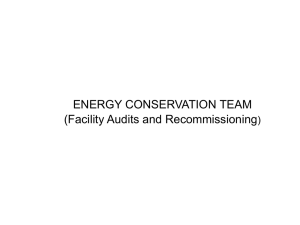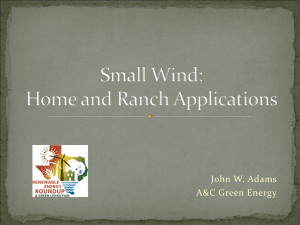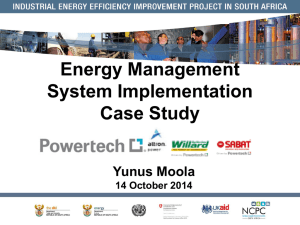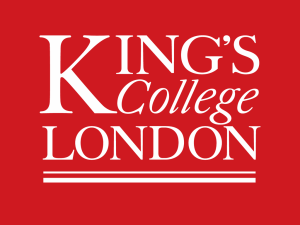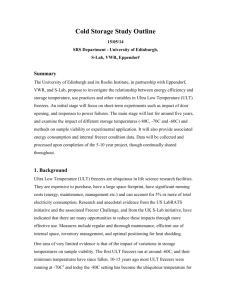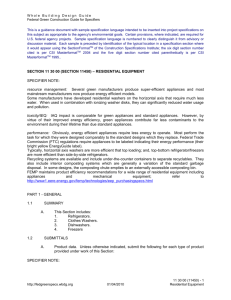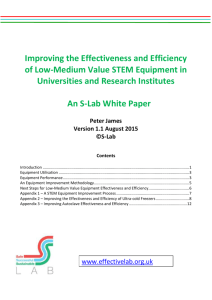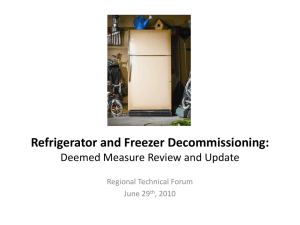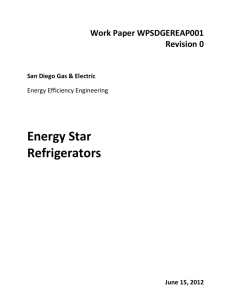Laboratory Auditing and Energy Efficiency (LEAF)
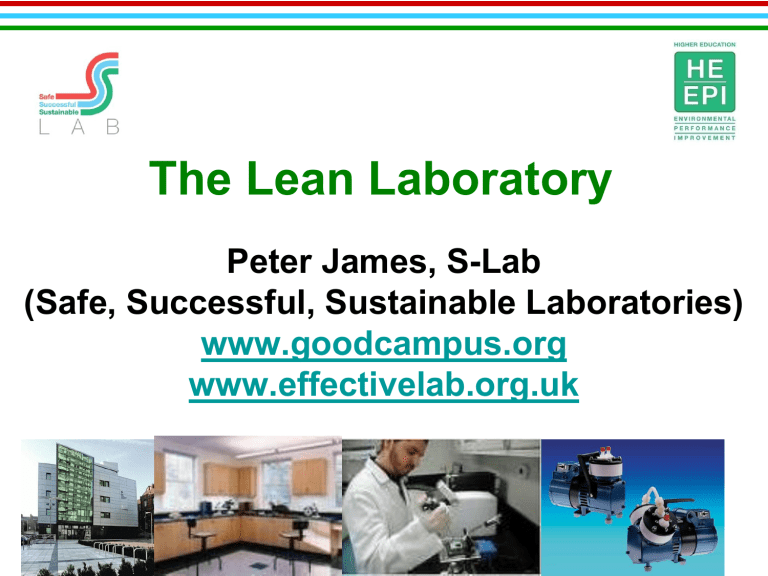
The Lean Laboratory
Peter James, S-Lab
(Safe, Successful, Sustainable Laboratories) www.goodcampus.org
www.effectivelab.org.uk
About Us
Linking key laboratory stakeholders
- e.g. researchers, lecturers, technical support, estates, designers & suppliers
Enabling strategic discussion of lab design, management and operation
- identifying and driving improvement
Conference and workshops
Awards scheme
Good practice advice/publications
Audit and assessment tools
2012 Award Winners
Imperial – Continuous Commissioning
Liverpool – Central Teaching Laboratory
Loughborough – Kit Catalogue
Oldham 6th Form College – Regional
Science Centre
Mike Foulkes/Plymouth – ISO 9001
Sheffield Hallam – Cell Culture Lab
St Andrews – Chemistry Teaching
Andrea Sella/UCL – Water Efficiency
Why Labs Will Change
Core to STEM institutions
Financial pressures
Student/staff expectations
Regulatory/stakeholder demands
Evident inefficiencies
More good practice examples
Developing capability/confidence
The Conference View
Is there scope to significantly increase the efficiency and effectiveness of labs, without compromising quality of work or safety?
- 66% said great scope
- 30% said some scope
What would most help to achieve this?
- more pressure from funders (60%)
- more focus by senior staff (57%)
- more cross-functional working (54%)
University of Liverpool
- Central Teaching Laboratory
University of St Andrews
- Chemistry Teaching Lab
Imperial College
- Continuous Commissioning
The Lab as a Business
A 10,000 m 3 + successful laboratory
£30 million + income streams
A building cost of £25-30 million
Equipment assets of £5-10 million
Operating costs of £15-20 million
Space costs of £300+ per m 2
Utilities £500,000 +
Materials/consumables £500,000+
Are assets and resources used effectively?
Are they understood?
Lab Energy Costs
Lab Audited
Liverpool -
Bioscience
Edinburgh –
Cancer Research
York - Biology
GIA/m2 Electricity cost £
Gas cost £
Total Energy
Cost £
7,750 247,000 60,000 307,000
3,000 152,000 48,000 200,000
12,740 373,000 102,000 475,000
Manchester -
Chemistry
Cambridge -
Chemistry
3,816 432,000 161,000 593,000
27,603 888,000 211,000 1,099,000
Lab Energy Split (£)
Bioscience Chemistry
Ventilation
(including related heating)
Equipment
45
25
60
15
Conventional
Heating/Hot Water
Lighting
20
10
20
5
Model
Freezer Energy Varies
Capacity Cost per
(litres) litre (£)
Annual running cost at 7.3p/kWh
570 0.54
£306 New Brunswick (Green model)
New Brunswick (Green)
New Brunswick (Green)
Van der Woude Revco
Lab Impex Research
Heraeus
Illshun DF8517
Kaye Sanyo MDF-U70V
New Brunswick
570
570
570
570
691
484
728
101
0.55
0.57
0.76
0.85
0.93
1.12
1.13
1.79
£314
£326
£434
£487
£641
£541
£824
£180
Case 2 – Better Chemical
Management, Edinburgh
Tracking all chemicals through barcoded containers
Users see in-house inventory when ordering
£100,000 first year savings of chemical purchasing costs
£12,000/year savings of management/disposal costs
Fast access to chemicals
Regular chemical audits
SciQuest e-procurement links
Derek Burgess,
Procurement Manager
Lean Lab Principles
– Equipment and Resources
Making issues visible
Addressing root causes
Right sizing
Adjusting to needs
Optimal efficiency
High utilisation
Effective management & communication
Rich information
Leaner Cold Storage
Making issues visible, e.g.
- total cost (incl space, heat load)
- compromised performance
- reporting/monitoring requirements
Addressing root causes, e.g.
- storing unwanted samples
- overly high storage temperatures
- lack of ownership
Right sizing
- based on actual storage needs
- standardised eqt sizes/procurement
Leaner Cold Storage
Adjusting to needs
- appropriate temperatures (storage policy)
- filling/blanking empty space
- modular spaces
Optimal efficiency
- regular maintenance
- cool locations
- buying high efficiency models
- chest rather than upright
- larger models
Leaner Cold Storage
High utilisation
- optimised containers & racking
- central services
- shelf/area allocation
Management and communication
- cross-functional approach
- clear responsibilities
- policies (storage, procurement etc)
- incentives (shared savings)
Rich information
- inventory management (expiry)
- individual bar coding
Leaner Chemicals
Making issues visible
- total costs (incl storage & disposal)
- waiting times
- reporting/security requirements
Addressing root causes
- nasty chemicals, why?
- concerns about purity
Right sizing
- smaller containers
Adjusting to needs
- microscale experiments
Optimal efficiency
Leaner Chemicals
High utilisation
- tracking amounts & locations
Effective management & communication
- policies
- shared savings
Rich information
- computerised database
Laboratory Energy Opportunities
Fabric & lighting (LED)
Wider operating parameters
Efficient/modular equipment
Low flow/alternative containment
Demand responsiveness
Free cooling/heating
High efficiency equipment
Eqt consolidation/sharing
Lay out & zoning
Storage policies/actions
Central services
Space efficient/natural write up
Supply
Building &
Services
Activities
Voltage optimisation/reduction
High efficiency transformers
High efficiency back up
Zero/low carbon sources
Thermal recovery/storage
Design &
Management
Good understanding
Effective maintenance
Monitoring/recommissioning
Right sizing
Energy awareness/incentives
Biosciences –
Big Energy Users
• Freezers (-20 and -80)
• Controlled environmental chambers
• Water baths
• Incubators
• Ovens
• Icemakers
• Hybridisers
• Autoclaves
• Mass spectrometers
• Laser microscopes
Chemistry –
Big Energy Users
• Hotplates/heater-stirrers
• Mass spectrometers
• Gas chromatography
• Rotary evaporators
• NMRs
• Ovens
• Fridges
• Pumps
• Water baths
Equipment
Freezer (-20)
Envtal chamber
Water bath
Incubator
Freezer (-80)
Oven
Ice maker
Hybridiser
Incubator-shaker
Thermal Cycler
(PCR)
Liverpool Bioscience
- Equipment
Typical Energy use peak rated per unit power (W) (kWh/year)
Total energy use
(kWh/year)
Costs
(£/year)
1,000
1500-2500
500 – 1500
850
1,200
1,500
2,400
750
1,500
250-1600
4380
8760
3276
3723
5256
4336.2
10512
3285
2592
288
249,660
105,120
101,556
89,352
73,584
47,698
31,536
19,710
18,144
9,504
19,973
8,410
8,124
7,148
5,887
3,816
2,523
1,577
1,452
760
Equipment Energy Varies
Biological
Safety Cabinet kWh
Trimat 2
(Ducted) 0.44
ESCO ACZ 4D1
(recirculating) 0.33
Annual running cost
@7.3p/kWh
£281.37
£211.03
Growth Cabinet
Annual
Running
Growth Cabinet kWh Cost
Sanyo Fitotron
Percival small
Conviron
20.64
26.90
£549
£716
Percival scientific 36.36
Sanyo 2
£968
62.0
£1,814
92.85
£2,711
-80 Freezer Costs
40
30
20
10
0
70
60
50
570L 725L 585L
Capacity (L)
760L
Data supplied by University of Newcastle
Min
Ave
Max
-80 Freezer Costs
For 725L freezer:
Energy ranged from 6,000 –21,000 kWh/y
Costs ranged from ~£500 - £1800/y
Difference = £1300/y PER FREEZER!
Procure Energy Efficient Freezers
Energy Star label for Lab Grade freezers
Case 5 – Replacing
Freezers at Newcastle
£725 litre freezer energy
- 6,000 –21,000 kWh/y
£180,000 of central funding to replace old models
36 -80 freezers replaced, saving 131,000 kWh
7 years, at 9.5p per kWh
Reduced space, more reliable
More £ for research
Clare Rogers, Director
Estates Support Services
Case 4 – Improved Sample
Tracking, Queen Mary
Blizard Institute Cell & Molecular Science
Combined 8 research centres, 40 liquid nitrogen dewars into centralised store
Barcode tracking & standardised containers
50% fewer samples
Easier sample retrieval
Less degradation risk
Human Tissues Act compliance easier
Lab Assessment
•Self-assessment tool for lab users (and estates)
•Inspired by work of LabRATS
•Building (high level) and Lab
Specific Assessment templates
•Lab specific assessment – 30 criteria in 9 categories
•Evidence of compliance
•Best practice guidance
•2-3 hrs per lab
Lab Assessment categories
Ambient conditions & ventilation
Chemicals and materials
Cold storage
Fume cupboards
Lighting
Scientific equipment
Waste & recycling
Water
Innovation

